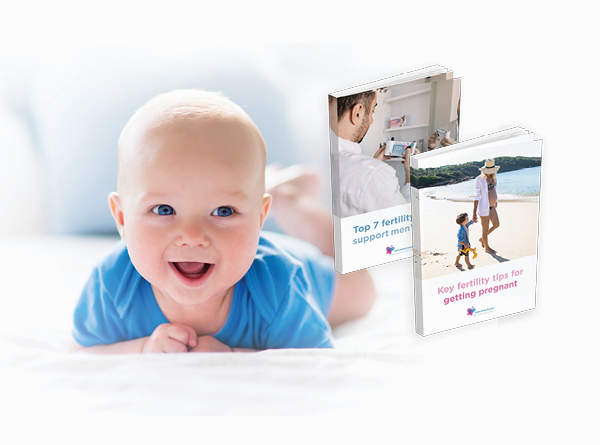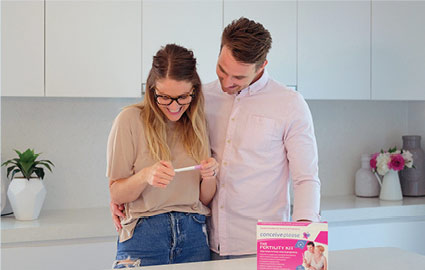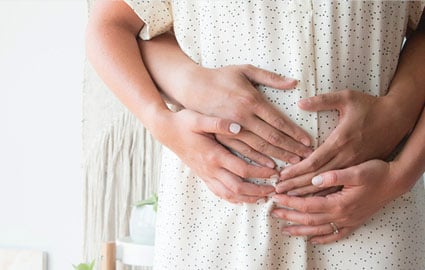When trying to conceive naturally, there are several factors to consider - from diet and alcohol intake to exercise habits and frequency of sex. There is also another, very important factor: timing. A huge part of successful natural conception is thoroughly understanding every stage of your menstrual cycle. Here’s a guide from day one to day 28 (or thereabouts!) to help you better understand your period cycle to make planning for a baby that little bit clearer.
Firstly - the stats.
A menstrual cycle is counted from the first day of your period until the first day of your next period, with a period cycle running from between 28 and 30 days for most women. Menstruation - that is, the period of discharge of the uterus lining that occurs if a released egg is not fertilised - can last between 3 to 5 days on average.
The peak chance for conception occurs during the ovulation stage of the reproductive cycle, which differs between women as it’s dependent on cycle length, regularity of menstruation and a number of lifestyle factors. While it is far easier to track ovulation if your period arrives each month like clockwork, only about 15 to 25% of couples will successfully conceive per month, with some 80% of couples conceiving within a year of trying.
Many statistical studies have been performed looking at the odds of conception over a time period. The results can be expressed in the table below:
| Monthly Chance of Conceiving Naturally | |
| Female age | Chance |
| 18-25 years | 20-25 % |
| 26-35 years | 15-20% |
| 36-40 years | 10% |
| 41-42 years | 5% |
| 43-45 years | 2% |
| > 45 years | 1% |
Essentially, a women has 12 periods in a year, so 12 eggs are released and therefore there are 12 chances of falling pregnant. While the stats may seem daunting, understanding the four key stages of your reproductive cycle is an important part of maximising your chances of natural conception.
Stage 1: The follicular phase
This phase begins on the first day of menstruation and its end is signaled by the ovulation stage. During the follicular phase of the reproductive cycle, the pituitary gland (which is located at the base of the brain and considered the ‘master gland’ of the body), releases a hormone that causes 10 to 20 follicles (cells containing immature eggs) to develop in the ovary. In turn, the ovaries also produce the hormone oestrogen, which thickens the lining of the uterus in preparation for a potentially fertilised egg to embed within it.
Usually just one follicle develops into a mature egg, which moves towards the surface of the ovary, at which time the second stage of the menstrual cycle - ovulation - begins.
Stage 2: Ovulation
With the mature egg at the edge of the ovary, your pituitary gland will then release a sudden surge of leutenizing hormone (LH), which ‘propels’ the egg from the ovary and into the fallopian tube, awaiting potential fertilisation from a sperm cell. Yes, the time to get intimate is at its peak!
One of the biggest questions regarding conception is how often couples should have sex during this stage. The short answer is, you can never have too much intercourse around your most fertile time - it’s important that you and your partner enjoy the journey! If you find that your reproductive cycle is a little irregular and you’re having difficulty pinpointing your ovulation stage, having sex every third day could help your chances of conceiving.
If fertilisation doesn’t occur, the egg will break down within about 24 hours. This means is that there is a very precise window during which successful conception could occur. Tracking your menstrual cycle to identify your ovulation is vital to maximise your chances. It’s also a good idea to pay attention to some of the other physical signs of ovulation:
- Cervical mucous: as you approach ovulation, your mucous will appear thinner, clearer and more ‘stretchy’
- Basal body temp BBT: your body temp will reduce slightly just before ovulation, then increase after ovulation and remain high. You can measure your BBT can be measured using our conceiveplease™ digital thermometer and Fertility Calendar
- The LH surge: you can detect the hormone surge in your urine with our conceiveplease™ One Step LH Urine Ovulation Test
While the general rule of thumb is that the ovulation cycle begins about 14 days before the start of a period, it is still not accurate enough to simply count the days, as it is possible that your reproductive cycles may differ slightly month to month. Keeping track of the above changes as well will give you a more holistic and accurate indication of your peak fertile period.
Stage 3 - the luteal phase
Beginning at the latter half of your menstrual cycle, the luteal phase is marked by the release of large amounts of progesterone from the remnants of the follicle (now referred to as the corpus luteum) that released the egg. If you’re trying to conceive, this is a very important stage of the cycle as the release of progesterone helps to thicken the lining of your uterus, which in turn allows a potentially fertilised egg to embed into it and begin growing.
If fertilisation doesn’t occur, the corpus luteum disintegrates. Consequently, progesterone levels decline and the lining of the uterus begins to break down. It’s during the luteal phase that women experience premenstrual symptoms like tender breasts, bloating, and mood swings - a good time to exercise a little self-care! Here are some ideas:
- Gentle exercise like a long walk in fresh air
- A warm bath infused with a few drops of ylang ylang, lemongrass or lavender to help you relax
- Cooking nutritious, hearty meals
- Limit your caffeine and alcohol consumption
Stage 4 - Menstruation
The breakdown of the uterus lining marks the start of menstruation, and the ending of a reproductive cycle. For most women, a period can last between 3 to 7 days, but many experience shorter or longer menstruation stages.
You might think that the discharge (menses) is just blood, but menstrual fluid also comprises cervical mucous and endometrial cells. It is entirely normal to lose between 50-100ml of fluid in a period, with heaviest flow occurring in the first couple of days.
While menstrual cycles can be regular for many women, there are instances where it may be advisable to see a doctor. Consult your GP if you experience any of the following:
- Excessively heavy bleeding for 8 days or longer
- Intense cramping that prevents you from undertaking regular activity
- Spotting in between periods
- Excessive breast pain
- Diarrhea or vomiting
I’ve got a regular cycle and have been tracking my ovulation but am still having difficulty conceiving. What other factors may affect my chances?
It’s important to keep in mind that there are many factors that come into play when trying to fall pregnant:
-
- Increasing female age: Chances of falling pregnant naturally reduces as your age increases each year. For example, at 40 years of age, you have approximately a 10 percent chance of conceiving, this drops to five percent by the age of 42.
- Frequency of sexual intercourse: The less often you have sex, the less likely the chance of conceiving.
- The regularity of the menstrual cycle: Most menstrual cycles are monthly, giving 12 episodes of ovulation each year. If sex is timed around ovulation then the ovulated egg has 12 chances of meeting the sperm each year. If menstrual cycles are infrequent or irregular then the chances of the egg and sperm meeting and fertilising will be less, thus reducing the odds of conceiving.
- Poor lifestyle factors: Studies have demonstrated reduced fertility in couples who smoke, consume excessive amounts of alcohol and who have a body mass index (BMI) greater than 30.
- The length of time a couple has been trying: Chances of falling pregnant reduces over time, with the most fertile of couples conceiving more quickly, while the lesser fertile couples taking longer to conceive.
- Health of your partner: lifestyle factors such as diet, exercise, and alcohol intake can all potentially affect fertility levels
For couples who have been trying to conceive for 12 months or longer it is recommended they seek fertility advice from a doctor or fertility specialist.
Sources:
https://womhealth.org.au/sites/womhealth/files/public/menstrual_cycle.pdf
https://www.betterhealth.vic.gov.au/health/conditionsandtreatments/menstrual-cycle
Your pregnancy journey
Preparing for pregnancy
A good preconception plan to educate yourself about your fertility cycle and implementing recommended lifestyle changes optimises your chances of conceiving naturally.
Monitoring ovulation
In order to pinpoint your fertile window, you need to be aware of the length of your menstrual cycle. The average length of menstruation is 28 days.
During pregnancy
The female body will evolve dramatically within this time and there are many nutritional and lifestyle changes that will be necessary to meet the needs of a growing healthy foetus.
Download your FREE e-books for top fertility tips to help you get pregnant





